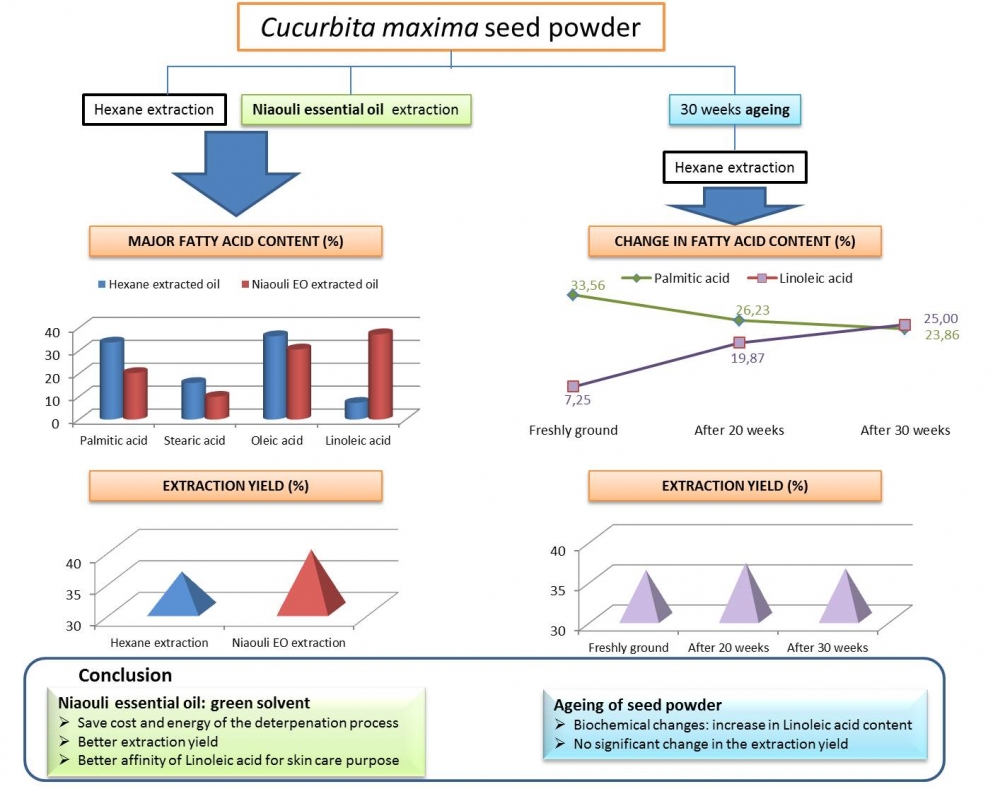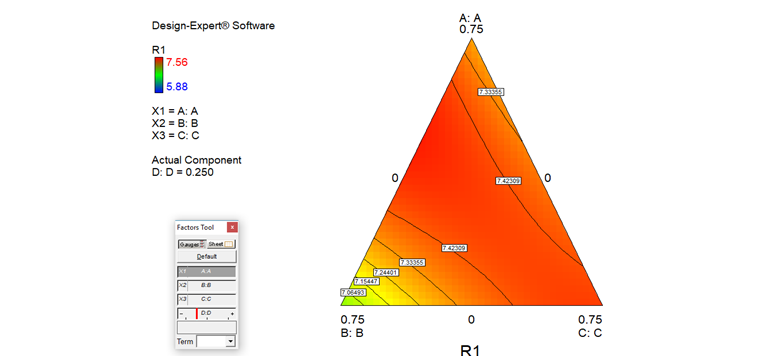Records of Agricultural and Food Chemistry
Year: 2023 Volume: 3 Issue:1 January-June
1) Seed Oil Extraction of Cucurbita maxima Duchesne Growing in Madagascar: Impact of Storage and Use of a Cineole–Rich Essential Oil as a Green Solvent

The performance of a cineole-rich essential oil as an extraction solvent for vegetable oil was studied. This essential oil was obtained from Melaleuca quinquenervia (Cav.) St Blake Myrtaceae, commonly called niaouli, an invasive plant on the eastern coast of Madagascar. The whole essential oil was used without preliminary isolation of terpenes. Experimentation was carried out with Cucurbita maxima Duchesne Cucurbitaceae seeds. The Soxhlet method was used for the oil extraction, and solvent recovery was performed by hydrodistillation. Niaouli essential oil allowed a better extraction yield of 39% compared to hexane, with 36%. The linoleic acid content of the oil was also higher: 37.19% against 7.25% for hexane. After 30 weeks of storage, the seed powder linoleic acid content increased to 44.99% for niaouli oil against 25.00% for hexane oil. With the screw press extraction method, the best yield of 13.00% was obtained with roasting pretreatment while heating at 60°C. However, the best oleic acid content of 45.36% was obtained at 50°C. It was demonstrated that the seed powder underwent biochemical changes during storage which were similar to intracellular catabolic reactions of fatty acids. The high expenses induced by the deterpenation process in terms of cost and energy limit the diffusion and the development of the use of terpenes as alternative solvents. The results of this research support the idea that it is possible to avoid this costly step by directly using the entire essential oil since this can provide a vegetable oil of good quality.
DOI http://doi.org/10.25135/rfac.15.2212.2662 Keywords Pumpkin seed oil green solvent Melaleuca quinquenervia linoleic acid skin care DETAILS PDF OF ARTICLE © 2023 ACG Publications. All rights reserved.2) An Application of Mixture Design: A Case Study on Blending of Olive Oils by Design-Expert

For quality control, raw material, semi-finished, and finished product analysis in chemistry, biochemistry, food, and environmental sciences, well-designed experimental strategies are needed to perform all experimental studies at minimum cost and under optimum conditions. The steps in the experimental strategies essentially constitute the experimental procedure followed, and here the aim is to select a model for the experimental procedure, to determine the number of experiments and experimental factor limitations for each run, to identify the correlation between experimental results and factors, and to optimise the experimental factors. The response surface methodology as an experimental design method also reduces the number of experiments required for multi-factor trials for optimisation. Mixture design, a special type of response surface function, is a very effective method for determining the proportions of components or variables in a mixture. A three-component mixture is represented by a triangle, which is a two-dimensional cross-section of a three-dimensional space represented by a cube representing the region where the proportions of the three components are added up to 100%. The points within this triangle or blend area represent possible blends, where: three corners correspond to single components, points along the edges to binary mixtures, the dots in the triangle to triad mixtures, and the centre of the triangle to an equal mix of all three components. Several common designs can be considered as ways to determine the logical number and arrangement of points in a simplex, the most well-known being the Simplex Centroid and Simplex Lattice patterns. This study focused on an experimental design application for fourteen blends of olive oils from four cultivars A–D mixed in the design presented together with a taste panel score for each blend and statistical evaluation of the results for mixture design applications. The higher the score is the better the taste of the olive oil. Here, the mixture design chosen for optimising blending ratios was Simplex-Lattice, and DesignExpert 7.3 software was used for statistical analysis. Comparing of calculated correlation coefficients of the response surface function and its parameters, and function constants, it could be understood that as the correlation coefficient would be 0.21 for used linear terms only, adding quadratic terms into the function increases it to 0.92 drastically.
DOI http://doi.org/10.25135/rfac.16.2303.2736 Keywords Olive oil blending mixture design response surface DETAILS PDF OF ARTICLE © 2023 ACG Publications. All rights reserved.3) Determination of Caffeine Amount of Organic and Conventional Coffees

Organic farming is a controlled and certified form of agricultural production at every stage, from production to consumption, without using chemical inputs in production. It has been suggested that there are differences in the amount of nutrients and non-nutrient compounds in foods produced by organic and conventional agriculture. In light of this information, the caffeine content of coffee, which is an important consumption product in our country and the world, has been evaluated in terms of organic and conventional coffees. For this purpose, 12 different types of organic (n=7) and conventional (n=5) coffees belonging to 5 different brands (A, B, C, D, E) offered for sale in the market were included in the sampling. The included brands were carefully selected to provide both organic and conventional options. The caffeine content of all ready-to-serve coffee samples was analyzed with high-pressure liquid chromatography (HPLC). The caffeine content of the coffees was expressed as mg/L, and the statistical analysis of the data was done with the SPSS 22.0 package program. The amount of caffeine (mg/L) in organic coffees was therefore found to be lower than that in conventional coffees when coffees are compared based on production methods (863.2181.46 mg/L, 1115.4380.88 mg/L, p<0.05, respectively). While the quantity of caffeine in organic coffee from three brands was found to be lower than that of conventional coffee (Organic and conventional, respectively; A: 694.9±31.73 mg/L and 1030.8±7.55 mg/L; D: 853.9±32.50 mg/L and 1576.4±250.94 mg /L; E: 1094.2±32.03 mg/L and 1470.7±13.45 mg/L; p<0.05), it was found that the converse was true for the other two brands when the amount of caffeine is compared according to both the production method and the brands (Organic and conventional, respectively; B: 904.9±189.54 mg/L and 831.3± 67.91 mg/L, C: 684.4±63.78 mg/L and 667.7±84.36 mg/L; p<0.05). The amount of caffeine in the coffees acquired using the conventional production method was higher than the coffee obtained using the organic production technique, and the amounts of caffeine in the coffees varied depending on the brands. This integrates the fact that the amount of caffeine in food can depend on whether or not production
DOI http://doi.org/10.25135/rfac.17.2305.2780 Keywords Caffeine Organic coffee Conventional coffee HPLC analysis DETAILS PDF OF ARTICLE © 2023 ACG Publications. All rights reserved.